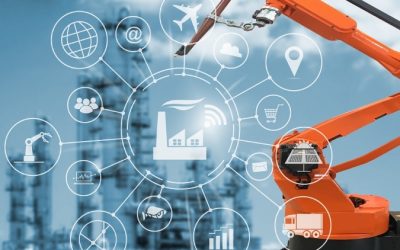Industrial IoT predictive maintenance is expected to generate the large scope of B2B transactions that require data analysis. Indeed, IIoT is on such a growth pattern many of the billions of connected things in the coming years will be industrial assets, which will be deployed in settings like factories, agricultural, oil refineries and energy plants.
According to McKinsey the Industrial Internet has the potential to deliver up to $11.1 trillion on an annual basis by 2025 and 70% of this is likely to concern industrial and business-to-business solutions i.e. the Industrial IoT is expected to be worth more than twice the value of the consumer internet.

The Industrial IoT is at the heart of the fourth industrial revolution (Industry 4.0), which is driven by the interconnection of all industrial assets and the ability to collect and analyze data from them. In the scope of the Industrial IoT, assets are cyber-physical systems, which enable the control of physical devices through their cyber representations and the processing of digital data about them.
The applications of cyber-physical systems span a very broad range, including production control, process optimization, asset management, integration of new technologies (such as 3D printing & additive manufacturing), as well as various industrial automation tasks. Nevertheless, the most prominent application is the ability to continually monitor, predict and anticipate the status of assets, with emphasis on industrial IoT predictive maintenance using predictions about when a piece of equipment should be maintained or repaired.
Industrial IoT Predictive Maintenance Key to Industry 4.0
Maintenance and Repair Operations (MROs) are at the heart of industrial operations, as they involve repairing mechanical, electrical, plumbing, or other devices as a means of ensuring the continuity of operations. Nowadays, the majority of MRO operations are carried out on the basis of a preventive maintenance paradigm, which aims at replacing components, parts or other pieces of equipment, prior to their damage that could catastrophic consequences such as low production quality and cease of operations for a considerable amount of time. However, in most cases preventive maintenance fails to lead to the best usage of equipment (i.e. optimal Operating Equipment Efficiency (OEE)), as it maintenance is typically scheduled earlier than actually required.
In industrial IoT predictive maintenance (PdM) alleviates the limitations of preventive approaches. PdM is based on predictions about the future state of assets, with particular emphasis on anticipating the time when an asset will fail in order to appropriately schedule its maintenance.
PdM is empowered by models that estimate when the cost of maintenance becomes (statistically) lower that the cost that is associated with the risk of equipment failure.
Based on an optimal scheduling of maintenance, PdM leads to improved OEE, enhanced employee productivity, increased production quality, reduced equipment downtime, as well as a safer environment where failures are anticipated and repairs proactively planned. McKinsey & Co. estimates that the economic savings of predictive maintenance could total from $240 to $630 billion in 2025.
Nevertheless, there are still many industries that dispose with preventive maintenance, since they have no easy way to integrate and analyze data sets from thousands of heterogeneous sensors that are typically available in their plant floors. As a result only a fraction (i.e. 1% according to McKinsey & Co) of the available data is used, which is a serious setback to unlocking the potential of predictive maintenance applications, such as maintenance as a service, on-line calculation of OEE risk, maintenance driven production schedules and more.
The advent of Industrial IoT predictive maintenance is gradually unlocking the potential of PdM technologies facilitate the collection and integration of data from thousands of different sensors, while at the same time providing the means for unifying the semantics of the diverse data sets. Furthermore, IoT analytics technologies (notably predictive analytics) facilitate the processing of IoT data streams with very high ingestion rates based on machine learning and statistical processing techniques that can predict the future condition of components and equipment.
In several cases, IoT data are processed by Artificial Intelligence based techniques such as deep learning, in order to identify hidden patterns about the degradation of assets. Deep learning techniques are capable of leveraging (multimedia) data from multiple maintenance modalities such as vibration sensing, oil analysis, thermal imaging, acoustic sensors and more. Moreover, advanced deployments of industrial IoT predictive maintenance are not limited to deriving predictions about the future state of assets. Rather, they are able to close the loop down to the plant floor, through for example changing configurations in production schedules, altering the operational rates of machines or even driving automation functions.
Rise of Industrial IoT Predictive Maintenance Products and Services
PdM is looming as one of the killer applications for the Industrial IoT, which is evident not only on its potential savings but also on the rise of relevant IoT-based products and services. Most vendors have been recently releasing IoT-based solutions for PdM. In addition to empowering data collection and analytics, vendors are striving to enhance their products with added-value functionalities that help them stand out in the market. For example:
- IBM predictive maintenance solution is able to perform root cause analysis in a holistic way, including predictions about where, when and why asset failures occur.
- Software AG’s solution for industrial IoT predictive maintenance integrates with ERP and human resources systems to automatically plan the optimal allocation of tasks to technicians.
- SAP integrates predictive maintenance information with business information (e.g., CRM and ERP systems) and enterprise asset management (EAM) systems. To this end, it benefits from its strong presence and installed base in the ERP market.
- Microsoft offers PdM solutions over its Azure IoT suite in a way that offers preconfigured solutions (templates) for monitoring assets and analyzing their usage in real-time.
Recently, the DataRPM platform has been also established by a consortium of different vendors and manufacturers. DataPRM claims ability to deliver Cognitive Predictive Maintenance (CPdM) for Industrial IoT, based on the use of Artificial Intelligence for automating predictions of asset failures and closing the loop to ERP, CRM, and other business information systems.
Other major players in industrial engineering and automation, such as SIEMENS and BOSCH are offering their own platforms, while all major IT consulting enterprises have relevant services in their portfolio. Nevertheless, it is indicative of the market momentum of PdM and its positioning as one of the most prominent applications in the growing Industrial IoT predictive maintenance market.








